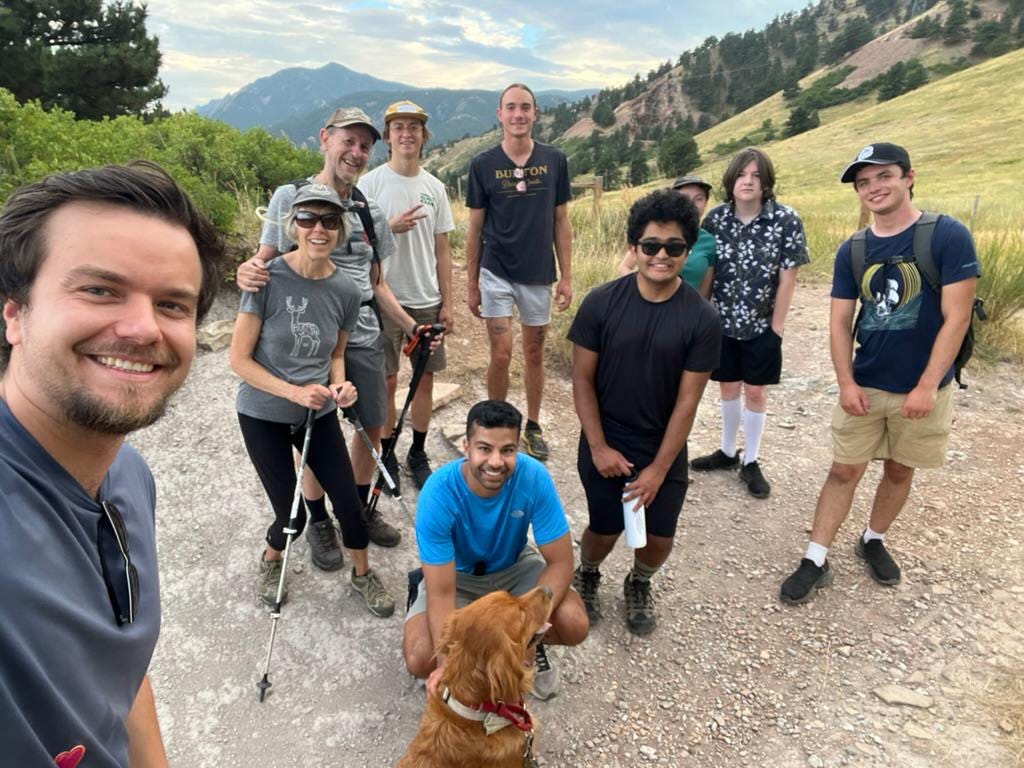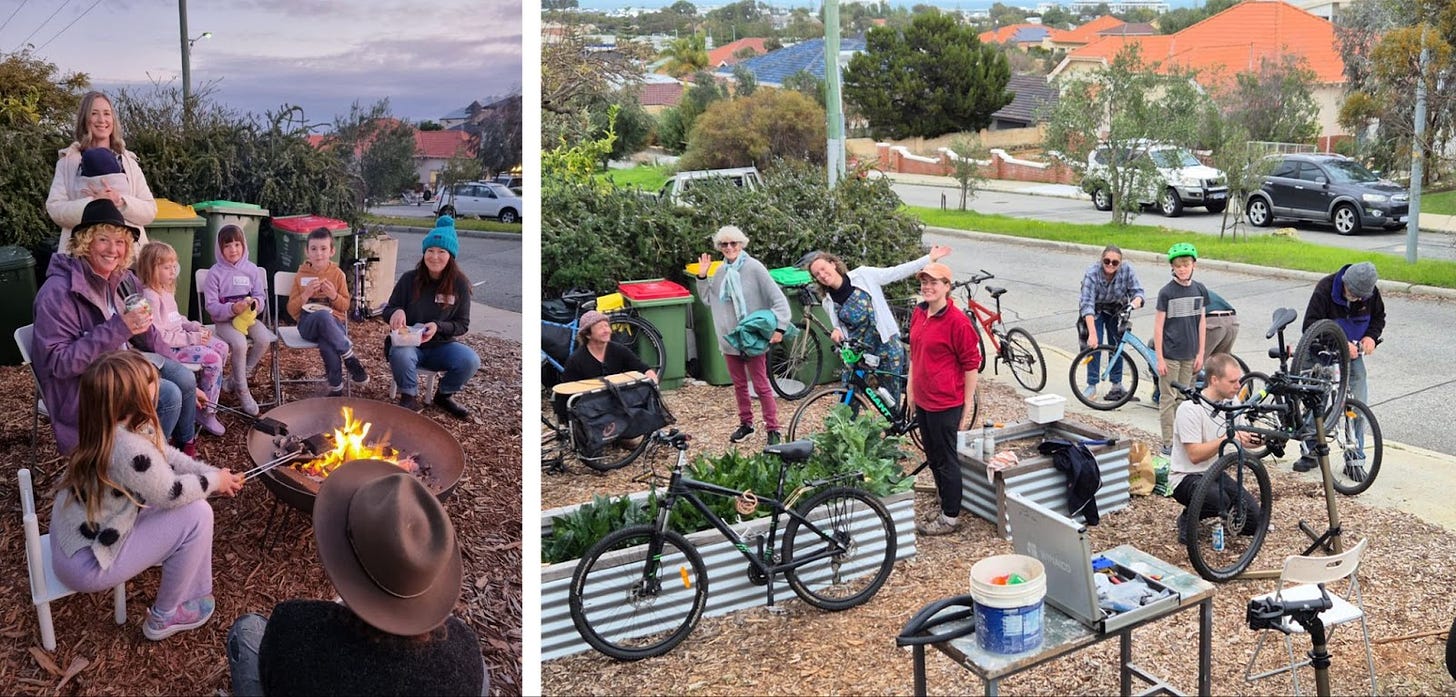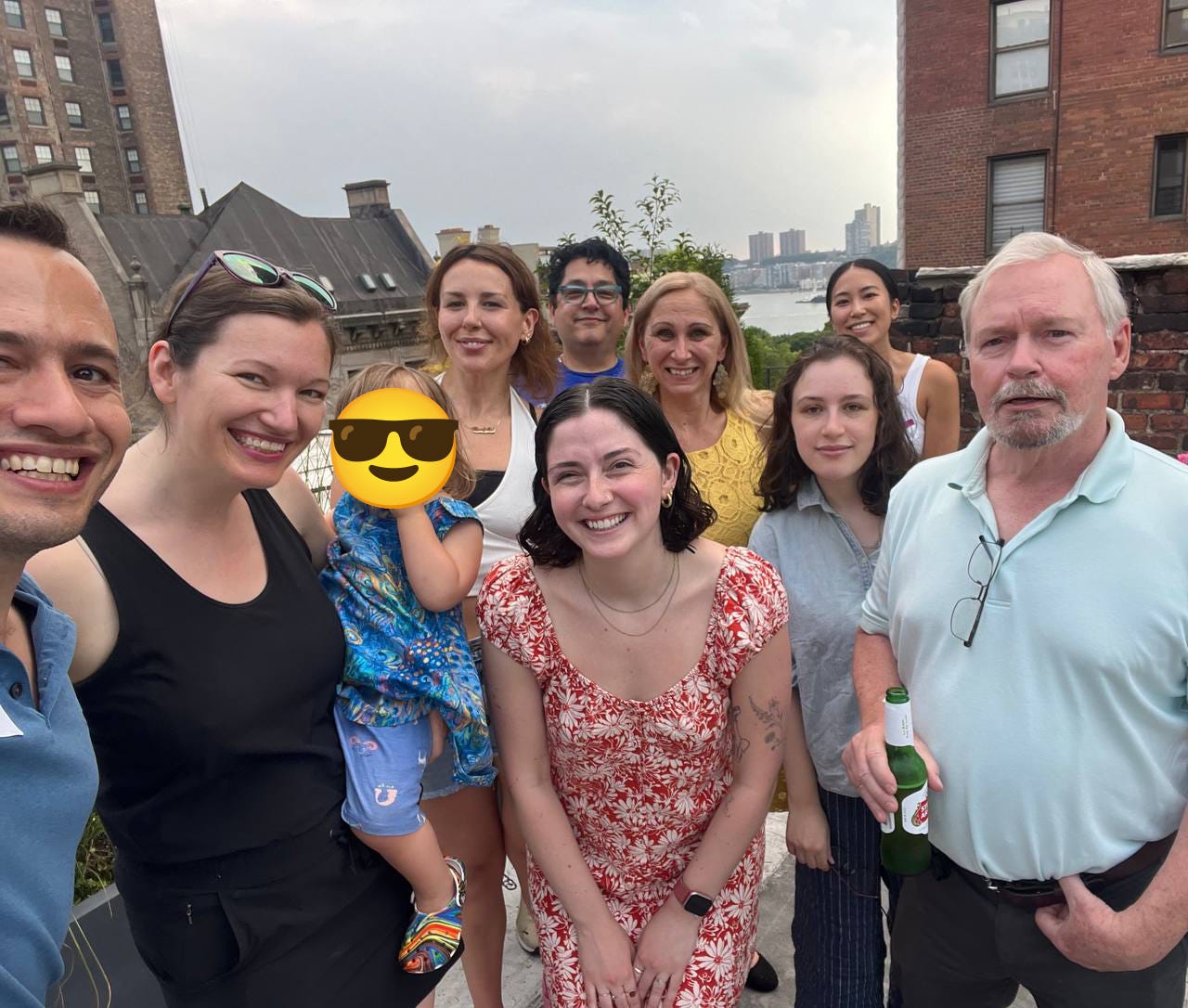Building neighborhood communities
3 Case Studies on making community with the folks already there
Note from the editors:
We are going to do something a little different here. Usually, we focus on people creating communities by moving people to the same property (e.g. into a coliving house or friend compound). But there’s another way to make community happen in a neighborhood: Create it with the folks that are already there.
Savannah Kruger has done this in her neighborhood in Boulder by doing the age-old work of meeting her neighbors. Now she’s helping others do the same in the Cabin Neighborhood Accelerator (2025 update: now called the Neighborhood Village Project).
Here are three case studies, including Savannah’s, on people who have made community happen in their own backyard.
Hi, I’m Savannah Kruger and I’m building a community of neighbors in Boulder, CO with my partner, Jon Bo.
The journey of neighborhood building can be lonely and challenging, so along the way, I created the Neighborhood Accelerator with an amazing group of humans. In this post, I want to share a few stories from the neighborhoods we are building.
Case Study 1: North Boulder Park

Neighborhood Stewards: Savannah Kruger & Jon Bo
Location: Boulder, CO
Origins
About a year and a half ago, we moved in together and fell in love with our neighborhood. We’re a short walk to North Boulder Park, a grocery store, our favorite coffee shop, amazing hiking trails, downtown restaurants, and the Boulder Creek. Location-wise, we were set. But it didn’t seem like there was much community in our neighborhood yet.
We started with our 31-unit apartment building and came up with our first event: a picnic potluck in the park. We made cute flyers, attached sticky notes with handwritten messages, and knocked on every door in our building. Out of 31 units, 15 people came to the first picnic. It was a little awkward at first, but after Jon and I started a few conversations and made some introductions, the group was vibing. People were talking about starting a community garden in the backyard of our building and about how much they loved our neighborhood. Jon asked the group if we’d like to start a group thread and we landed on Discord (then later switched to WhatsApp). People use the WhatsApp to coordinate events and impromptu hangs, water each other's plants, give away things they no longer need, ask to be let into the building when they get locked out, ask for help jumping cars… that sort of thing.
Since that initial picnic, we've made an effort to meet every person in our building and engage the surrounding blocks. We’ve made cute, hand-drawn flyers (our neighbor, Anastasia, did the drawings for the September one below!) and we’re now giving stacks of flyers to other involved neighbors to distribute to their buildings. Turns out there are pockets of community in some of the other apartment buildings too and we’re beginning to weave with them.

The best thing is that we’ve started making thoughtful asks of neighbors to participate (everything from doing the dishes to drawing the flyer to hosting events) and most folks we ask are excited to get involved. One neighbor organized potluck dinners where we all made a new recipe from a certain cuisine we wanted to try. A group is forming to organize an Autumn Block Party and then a field day in the park to keep the momentum going. Another group is looking into how to make a certain street in our neighborhood safer for pedestrians.
Our relationship to this place is meaningfully different from when we first moved in. Going to the park could easily mean bumping into friends or meeting a new neighbor.
Lessons Learned
Love the Ones You’re With
We originally wanted to get a bunch of our friends to move into our building (and we still do). But at least in our context, with our group of friends, it felt like a far-off dream to get anyone to move in in less than a year. So we figured: why don’t we build a wholesome-ass community with the people who are already here and in so doing, we’ll make this place even more appealing to our friends. And it’s working. Jon’s good friend just moved into our building last month.
The Filter of Neighborliness
The people who say yes to hanging out with their neighbors are generally lovely humans. They value community enough to show up. And the people who don’t want to be there don’t answer the door and don’t come. At first, we were concerned that interacting with our neighbors would feel like Nextdoor, and we’ve definitely met some characters, but on the whole, there are folks in our neighborhood that we want in our lives for a long time.
Case Study 2: West Beacy Bunch
Neighborhood Steward: Shani Graham
Location: Beaconsfield, Australia (see the map of their neighborhood)
The best way to understand the story of the West Beacy Bunch is to watch Shani’s TEDx talk below. I stumbled upon this video while designing the program and nearly did a spit-take. A few weeks later, Shani was a mentor in the program and has been deeply involved ever since.
Origins
The story of Shani’s neighborhood begins back in 2019 when she led a sustainability course on things everyday people can do to make their households more sustainable and resilient. Turns out her neighbor, Carrie Page, was in the audience and was deeply inspired by Shani’s work. They became fast friends and decided to build a community in their neighborhood together. They got out a map and drew a line around the 350 houses in their neighborhood. Then they got two extremely cute kids to join them as they walked door-to-door. The cuteness of the kids’ invitation to “come to our picnic and meet your neighbors” was enough to get 100 people to their first community picnic. When the big day arrived, Shani, the facilitator that she is, put out three poster boards: 1) a blown-up map of their neighborhood for people to reference when connecting with neighbors, 2) a board entitled “What could we do together?” and 3) another board entitled “What should we call ourselves?” By the end of the picnic, they had a list of events and projects folks wanted to do together and they had a name: the West Beacy Bunch.
Shani and Carrie empowered their neighbors to come up with events that they were passionate about + take charge of organizing them. Movie screenings in the park, bread-making workshops, holiday caroling around the neighborhood, clothing swaps, winter solstice bonfires…and the highlight of the year is always Whitney’s long table dinner (seen above). As the community grew, subgroups formed around specific projects such as establishing a community garden, planting native seedlings, and interviewing long-term residents to compile a living history of the neighborhood.
The community they built during good times made them resilient in bad times. When the pandemic struck, the West Beacy Bunch were able to respond: Nicole, a psychologist and member of the Bunch, set up a community hotline and neighbors distributed informational flyers to every household. They recruited 30 volunteers within the Bunch to provide essentials like groceries, medicine, toilet paper, etc. + emotional support to more vulnerable neighbors. And they organized all of this in about 24 hours a week before lockdown started in Australia. Incredible.
Lessons Learned
Do-ocracy
Shani’s partner Tim has a saying that I love: “If you have an idea, you have a job.” The West Beacy Bunch challenges neighbors to “do the thing” rather than ask for permission or wait for someone else to do it. And this culture of agency and trust started early on when Shani made a point to give neighbors jobs to do at events.
Jobs = Belonging
In the program, Shani shared: “When I plan an event I don’t run it unless I can think of at least 6 jobs to give people who attend.” At one event she hosted there were a bunch of chairs already out in the perfect spots for the event and she put them away just so folks could help her put them out again! Thoughtfully asking people to do things is a great way to give them a sense of ownership and thus belonging.
Resilient neighborhoods are not run by one person, they’re a function of many empowered, deeply bonded people working together. Shani alone couldn’t have created that full-neighborhood response to the pandemic. But by continuously asking people to contribute and celebrating them for it, she and her neighbors fostered a culture of true resilience.
Case Study 3: The Manhattan 75
Neighborhood Steward: Bethany Crystal
Location: W 75th Street in New York City
Origins
Bethany: I started the Manhattan 75 block association after feeling isolated when I had my first baby during the onset of the pandemic. The usual maternity leave activities like meeting other new moms were out of reach, and many of my friends moved away from the city, leaving me without a support network. After moving apartments twice (including once under duress, when we discovered toxic black mold in the baby’s bedroom), I realized that our next chapter of living in New York City was not going to look like the ones that preceded it.
Drawing from my experience as a community builder in the tech industry, I knew that creating a sense of ownership and connection was essential for my family to feel at home. With two children and a husband, we wanted to feel rooted and civically engaged in our neighborhood, so I decided to launch a block association to foster a sense of belonging and community on the Upper West Side.
I started with our building, which has about 30 units, and knocked on each door to invite people to dinner on our rooftop deck (see the picture above). We had a lovely time and started a WhatsApp thread. We started a few micro-projects — including setting up a lending library in the lobby of our apartment building and teaming up to fix a broken window.
Over the past three months, we’ve connected with about 50 people on the block, through a picnic in Riverside Park (at the end of our street), a lemonade stand run by my daughters, and a small outdoor garden installation in an abandoned tree well. At one of these gatherings, I asked the group what we should call ourselves. After a great conversation, the neighbors coined our nickname and a recent Parsons graduate designed our logo. Thus, the Manhattan 75 was born.
Lessons Learned
Building a local community on the Upper West Side has taught me that the pace of connecting with neighbors here is different from other places. Starting in Summer proved challenging for recruitment and momentum, with many residents away on vacation.
I've learned that communication strategies differ between individual buildings and the block as a whole. A strategy I'm testing involves finding point people in each building to manage a group chat, which then connects to a larger block-wide group. This approach has shown promise and is something I plan to double down on. As we move forward, I'm excited to see how our efforts will come together, especially with the big block party we're planning for the fall.
—
Building Neighborhoods Together
Want to get involved?
After seeing the early fruits of our neighborhood building efforts in Boulder, I (Savannah) joined the Cabin team to run the Neighborhood Accelerator program and help people build communities in their neighborhoods. We created a global neighborhood building community of practice with 15 people representing 10 neighborhoods around the world. We brought in mentors like Priya Rose, Phil Levin (y’all know him 😉), Graham McBain, and Shani Graham (from Case Study 2). We did the basic steps of neighborhood building together: designing an event, inviting neighbors, running the event, creating a communication channel, getting neighbors involved in leading things, and so on. We supported each other through the challenges and celebrated the wins.
There are so many other stories from our first cohort that could have been shared in this post: Dahveed making emergency backpacks for neighbors in case of a missile strike in Israel, Kathi starting a family-friendly coworking group for parents in Portugal, Cam and Shirah creating emergency preparedness infrastructure in Oakland, Forest running an intergenerational summer camp with his neighbors in Olympia…
As we draw Cohort 1 to a close, I want to extend an invitation to anyone who feels inspired by these stories to join us in a future round of the program. The Supernuclear community’s collective wisdom has inspired me for years and it would be a true honor to build neighborhoods alongside you all. If you feel called to build lasting community in your neck of the woods, you can apply here. And if you’d be excited to mentor the folks doing this work, I’d love to connect. You can email me at savannah@cabin.city.










Wanted to share an update with you all on how it's going given that this post was super influential in connecting us with incredible folks from the Supernuclear readership who want to build neighborhoods too.
We got 50 applications and of that our second cohort will consist of 30-35 neighborhood stewards. We start next Monday and I truly couldn't be more inspired and excited. Here's an updated map of the locations they're hailing from: https://felt.com/map/Cabin-Neighborhood-Accelerator-Locations-4ylw31PvQjiCOOkkFYMJrC?loc=11.7,16.13,2.64z I recommend you zoom in on the Bay, NYC, and Australia to see some fun neighborhood clusters.
i just love -love- this Savannah. congrats! And north boulder is so great as a playground.